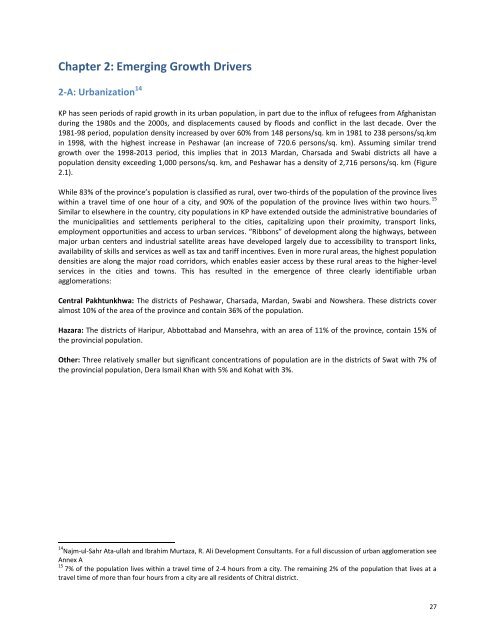1NpGng0
1NpGng0
1NpGng0
Create successful ePaper yourself
Turn your PDF publications into a flip-book with our unique Google optimized e-Paper software.
Chapter 2: Emerging Growth Drivers2-A: Urbanization 14KP has seen periods of rapid growth in its urban population, in part due to the influx of refugees from Afghanistanduring the 1980s and the 2000s, and displacements caused by floods and conflict in the last decade. Over the1981-98 period, population density increased by over 60% from 148 persons/sq. km in 1981 to 238 persons/sq.kmin 1998, with the highest increase in Peshawar (an increase of 720.6 persons/sq. km). Assuming similar trendgrowth over the 1998-2013 period, this implies that in 2013 Mardan, Charsada and Swabi districts all have apopulation density exceeding 1,000 persons/sq. km, and Peshawar has a density of 2,716 persons/sq. km (Figure2.1).While 83% of the province’s population is classified as rural, over two-thirds of the population of the province liveswithin a travel time of one hour of a city, and 90% of the population of the province lives within two hours. 15Similar to elsewhere in the country, city populations in KP have extended outside the administrative boundaries ofthe municipalities and settlements peripheral to the cities, capitalizing upon their proximity, transport links,employment opportunities and access to urban services. “Ribbons” of development along the highways, betweenmajor urban centers and industrial satellite areas have developed largely due to accessibility to transport links,availability of skills and services as well as tax and tariff incentives. Even in more rural areas, the highest populationdensities are along the major road corridors, which enables easier access by these rural areas to the higher-levelservices in the cities and towns. This has resulted in the emergence of three clearly identifiable urbanagglomerations:Central Pakhtunkhwa: The districts of Peshawar, Charsada, Mardan, Swabi and Nowshera. These districts coveralmost 10% of the area of the province and contain 36% of the population.Hazara: The districts of Haripur, Abbottabad and Mansehra, with an area of 11% of the province, contain 15% ofthe provincial population.Other: Three relatively smaller but significant concentrations of population are in the districts of Swat with 7% ofthe provincial population, Dera Ismail Khan with 5% and Kohat with 3%.14 Najm-ul-Sahr Ata-ullah and Ibrahim Murtaza, R. Ali Development Consultants. For a full discussion of urban agglomeration seeAnnex A15 7% of the population lives within a travel time of 2-4 hours from a city. The remaining 2% of the population that lives at atravel time of more than four hours from a city are all residents of Chitral district.27


